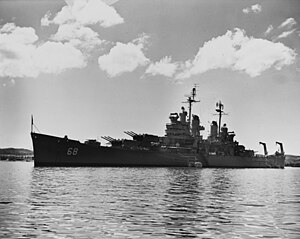| USS Baltimore (CA-68) | |
|---|---|
 | |
| Career (United States) | |
| Laid down: | 26 May 1941 |
| Launched: | 28 July 1942 |
| Commissioned: | 15 April 1943 |
| Decommissioned: | 31 May 1956 |
| Struck: | February 1971 |
| Fate: | Scrapped in 1972 Zidell Ship Dismantling Company Portland, Oregon |
| General characteristics | |
| Displacement: | 13,600 tons |
| Length: | 673 ft 5 in (205.3 m) |
| Beam: | 70 ft 10 in (21.4 m) |
| Draft: | 26 ft 10 in (18 m) |
| Speed: | 33 knots |
| Complement: | 1142 officers and enlisted |
| Armament: |
9 × 8"/55 main battery 12 × 5"/38 dual purpose secondary battery 48x40mm AA guns 24x20mm AA guns. |
| Aircraft carried: | 4 x OS2U Kingfisher |
| Aviation facilities: |
In stern hangar for 4 aircraft(wings folded) 2 catapults |
The fifth USS Baltimore (CA-68), the lead ship of a Baltimore-class heavy cruiser, was launched 28 July 1942 by Bethlehem Steel Company, Fore River, Massachusetts, sponsored by Mrs. Howard W. Jackson, wife of the Mayor of Baltimore, commissioned 15 April 1943, Captain Walter C. Calhoun in command, and reported to the Pacific Fleet.
World War II[]
Between November 1943 and June 1944 Baltimore was a unit of the fire support and covering forces at the Makin Islands landings (20 November – 4 December 1943); Kwajalein invasion (29 January – 8 February 1944), and the Truk raid (16–17 February) and Eniwetok seizure (17 February – 2 March). On the 17th, Lt. (j.g.) Denver M. Baxter, USNR, flying one of the heavy cruiser's Vought OS2U Kingfishers, covered by two F6F Hellcats, rescued Lt. (jg.) George M. Blair, USNR, of VF-9 less than 6,000 yards from Dublon Island inside Truk lagoon where he had ditched his flak crippled Hellcat.
Baltimore continued to provide fire support in the Marianas attacks (21–22 February), the Palau-Yap-Ulithi-Woleai raid (30 March – 1 April); the Hollandia (currently known as Jayapura) landing (21–24 April); the Truk-Satawan-Ponape raid (29 April – 1 May), air strikes against Marcus Island (19–20 May) and Wake Island (23 May), the Saipan invasion (11–24 June); and the Battle of the Philippine Sea (19–20 June).
Returning to the United States in July 1944, she embarked President Franklin D. Roosevelt and his party and steamed to Pearl Harbor. After meeting with Admiral Chester Nimitz and General Douglas MacArthur, the President was carried to Alaska where he departed Baltimore 9 August 1944.
Returning to the war zone in November 1944, she was assigned to the 3rd Fleet and participated in the attacks on Luzon (14–16 December 1944; and 6–7 January 1945); Formosa (3–4, 9, 15, and 21 January); the China coast (12 and 16 January); and Okinawa (22 January).
On 26 January she joined the 5th Fleet for her final operations of the war: Honshū Island attacks (16–17 February); Iwo Jima operation (19 February – 5 March); and the 5th Fleet raids in support of the Okinawa operation (18 March – 10 June).
After the cessation of hostilities Baltimore served as a unit of the "Magic Carpet" fleet and then as a part of the naval occupation force in Japan (29 November 1945 – 17 February 1946). Departing the Far East 17 February 1946 she returned to the United States and went out of commission in reserve 8 July 1946 at Bremerton, Washington.
Baltimore was recommissioned 28 November 1951 and assigned to the U.S. Atlantic Fleet. She was deployed with the 6th Fleet in the Mediterranean during the summers of 1952, 1953, and 1954. In June 1953 she represented the United States Navy in the British Fleet Review at Spithead, England. On 5 January 1955 she was transferred to the Pacific Fleet and was deployed with the 7th Fleet in the Far East between February and August 1955.
Fate[]

Baltimore being dismantled at Zidell shipbreaking yard in September 1972.
Baltimore commenced pre-inactivation overhaul upon her return from the Far East and went out of commission in reserve at Bremerton, 31 May 1956. She was struck from the Navy List 15 February 1971, sold 10 May 1972, and subsequently scrapped at Portland, Oregon September 1972.
Awards[]
Baltimore received nine battle stars for her service in the Pacific during World War II.
North Korean Museum[]
A museum in Pyongyang, North Korea, preserved a poster claiming that the Baltimore was sunk by the Korean People's Navy on 2 July 1950. A torpedo boat which 'sank it' is also displayed there. Though the actual battle occurred in 1950, the Baltimore was held in decommissioned reserve from 1946 to 1951. She was then once again commissioned, but assigned to the Atlantic Fleet until 1955. The battle actually involved the USS Juneau as well as HM Ships Black Swan and Jamaica, who together destroyed several North Korean torpedo boats escorting supply vessels without any significant return fire from the North Koreans.
External links[]
| Wikimedia Commons has media related to USS Baltimore (CA-68). |
This article incorporates text from the public domain Dictionary of American Naval Fighting Ships.
The original article can be found at USS Baltimore (CA-68) and the edit history here.

